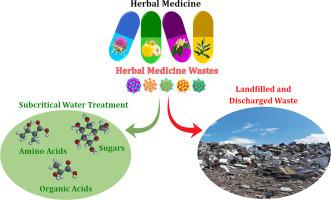Journal of Hazardous Materials ( IF 12.2 ) Pub Date : 2021-09-20 , DOI: 10.1016/j.jhazmat.2021.127294 Maryam Jouyandeh 1 , Omid Tavakoli 2 , Reza Sarkhanpour 2 , S Mohammad Sajadi 3 , Payam Zarrintaj 4 , Navid Rabiee 5 , Omid Akhavan 5 , Eder C Lima 6 , Mohammad Reza Saeb 7

|
Herbal medicine wastes (HMWs) are byproducts of medicine factories, which are mainly landfilled for their environmental problems. Only bearing in mind the contamination and concerns caused by the COVID-19 pandemic and environmental emissions, the worth of herbal medicine wastes management and conversion to green products can be understood. In this work, subcritical water treatment was carried out batch-wise in a stainless tube reactor in the pressure range of 0.792–30.0 MPa, varying the temperature (127–327 °C) and time (1–60 min) of extraction. This resulted in new and green material sources, including organic acids, amino acids, and sugars. Amazingly, at very low extraction times (below 5 min) and high temperatures (above 277 °C), about 99% of HMWs were efficaciously converted to clean products by subcritical hydrothermal treatment. The results of hydrothermal extraction after 5 min indicated that at low temperatures (127–227 °C), the total organic carbon in the aqueous phase increased as the residual solid phase decreased, reaching a peak around 220 °C. Acetone soluble extracts or fat phase appeared above 227 °C and reached a maximum yield of 21% at 357 °C. Aspartic acid, threonine, and glycine were the primary amino acids; glycolic acid, formic acid, lactic acid, and acetic acid were obtained as the main organic acids, glucose, fructose, and cellobiose were substantial sugars produced from the aqueous phase after 5 min of hydrothermal subcritical hydrolysis extraction.
中文翻译:

亚临界水处理中草药废料的绿色产品
草药废物 (HMWs) 是药厂的副产品,主要是由于环境问题而被填埋。只有牢记 COVID-19 大流行和环境排放造成的污染和担忧,才能理解草药废物管理和转化为绿色产品的价值。在这项工作中,亚临界水处理在不锈钢管反应器中在 0.792-30.0 MPa 的压力范围内分批进行,改变提取的温度(127-327°C)和时间(1-60 分钟)。这产生了新的绿色材料来源,包括有机酸、氨基酸和糖。令人惊讶的是,在极短的萃取时间(低于 5 分钟)和高温(高于 277 °C)下,约 99% 的 HMW 通过亚临界水热处理有效转化为清洁产品。5 分钟后的水热提取结果表明,在低温(127-227°C)下,水相中的总有机碳随着残留固相的减少而增加,在 220°C 左右达到峰值。丙酮可溶性提取物或脂肪相出现在 227 °C 以上,并在 357 °C 时达到 21% 的最大收率。天冬氨酸、苏氨酸和甘氨酸是主要氨基酸;得到乙醇酸、甲酸、乳酸和乙酸作为主要有机酸,葡萄糖、果糖和纤维二糖是水热亚临界水解提取 5 分钟后从水相中产生的主要糖类。在 220 °C 左右达到峰值。丙酮可溶性提取物或脂肪相出现在 227 °C 以上,并在 357 °C 时达到 21% 的最大收率。天冬氨酸、苏氨酸和甘氨酸是主要氨基酸;得到乙醇酸、甲酸、乳酸和乙酸作为主要有机酸,葡萄糖、果糖和纤维二糖是水热亚临界水解提取 5 分钟后从水相中产生的主要糖类。在 220 °C 左右达到峰值。丙酮可溶性提取物或脂肪相出现在 227 °C 以上,并在 357 °C 时达到 21% 的最大收率。天冬氨酸、苏氨酸和甘氨酸是主要氨基酸;得到乙醇酸、甲酸、乳酸和乙酸作为主要有机酸,葡萄糖、果糖和纤维二糖是水热亚临界水解提取 5 分钟后从水相中产生的主要糖类。











































 京公网安备 11010802027423号
京公网安备 11010802027423号